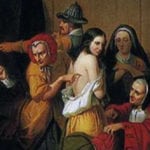 Mysteries
Mysteries  Mysteries
Mysteries  History
History 10 Surprising Stories About the Texas Rangers
 Humans
Humans 10 Philosophers Who Were Driven Mad by Their Own Theories
 Miscellaneous
Miscellaneous 10 Video-Game-Worthy Weapons and Armors from History
 Weird Stuff
Weird Stuff 10 Psychics Who Accurately Predicted Wartime Events
 The Arts
The Arts 10 Pieces of Art Inspired by a Broken Heart
 Health
Health 10 Science Fiction-Sounding New Medical Treatments
 History
History 10 Surprising Facts About the Father of Submarine Warfare
 Space
Space Ten Astonishing New Insights into Alien Worlds
 Weird Stuff
Weird Stuff 10 Bizarre Summer Solstice Rituals Still Practiced Today
 Mysteries
Mysteries Top 10 Haunting Facts About the Ghost Ship MV Alta
 History
History 10 Surprising Stories About the Texas Rangers
 Humans
Humans 10 Philosophers Who Were Driven Mad by Their Own Theories
Who's Behind Listverse?

Jamie Frater
Head Editor
Jamie founded Listverse due to an insatiable desire to share fascinating, obscure, and bizarre facts. He has been a guest speaker on numerous national radio and television stations and is a five time published author.
More About Us Miscellaneous
Miscellaneous 10 Video-Game-Worthy Weapons and Armors from History
 Weird Stuff
Weird Stuff 10 Psychics Who Accurately Predicted Wartime Events
 The Arts
The Arts 10 Pieces of Art Inspired by a Broken Heart
 Health
Health 10 Science Fiction-Sounding New Medical Treatments
 History
History 10 Surprising Facts About the Father of Submarine Warfare
 Space
Space Ten Astonishing New Insights into Alien Worlds
 Weird Stuff
Weird Stuff 10 Bizarre Summer Solstice Rituals Still Practiced Today
10 Psychiatric Diagnoses Of Horror Villains And Their Victims
Not surprisingly, many horror movie villains suffer from serious mental illnesses, mental disorders, or physical diseases that cause bizarre behavior. Becoming monsters, they commit atrocities on innocent victims, stalking, murdering, raping, molesting, and bullying their prey.
A vicious cycle of torment, suffering, madness, and crime is sometimes created in which the victims become the victimizers of still others who are frequently guilty of nothing more than being in the wrong place at the wrong time. Their behavior is so hideous that some confuse their deeds with the acts of demonic beings, immortal bogeymen, mutants, ghosts, or the very devil himself.
While these films often allow the possibility of both a supernatural and a natural explanation of the events they depict, medical science typically allows but one cause, although the cause, mental illness, whether it applies to a movie’s villain or victim, like Stephen King’s monstrous It, takes many forms, all horrific and terrible to behold.
Top 10 Classic Horror Movie Misconceptions
10 Michael Myers and Laurie Strode
From a psychiatric perspective, the portrayal of mentally disturbed characters in horror films, as in other cinematic genres, is often “wildly inaccurate.” Nevertheless, Rutgers University students in Professor Anthony Tobia’s REDRUM course watch horror movies, including Psycho (1960), Halloween (1978), and A Nightmare on Elm Street (1984).
Tobia instructs them to avoid taking “the movies at face value,” and to, instead, “focus on an abstract and symbolic understanding of the plot summary or aspects of character analysis . . . germane to [discussions of] a full spectrum of mental illnesses.”
The class determined that, as a result of having killed his sister Judith, Michael Myers (Halloween) suffers from conversion disorder (the sudden onset of the experience of blindness, paralysis, or other symptoms), which is manifest in his inability “to speak after murdering his sister,” and from voyeurism and autism.
After his escape from a mental hospital, Myers returns home, seeking to kill his other sister Laurie Strode, whose surname differs from that of Michael and Judith because, following their parents’ murders, Laurie was put up for adoption.
His stalking of her and his attempts to kill her cause Laurie to suffer from stress, but her therapist informs her, in Halloween II (1981), that she suffers from the same “illness” as her brother. However, if Tobia’s students are correct in their diagnosis of Michael, it is unclear what the therapist meant, since Laurie is not shown as suffering from conversion disorder, voyeurism, or autism.
Perhaps the therapist was referring to the diagnosis of Sam Loomis, Michael’s psychiatrist, who identified him as “pure evil,” although such a diagnosis is not, of course, strictly speaking, in any volume of the profession’s “Bible,” the Diagnostic and Statistical Manual (DSM).
9 Hannibal Lecter and Clarice Starling
Although Dr. Glen O. Gabbard’s observations concerning Hannibal Lecter are based on Thomas Harris’s novels, Gabbard’s views are pertinent to the film’s adaptation, too, since the movie franchise featuring Lecter and FBI agent Clarice Starling is founded on Harris’s books.
Gabbard finds the psychology behind Hannibal (1999) rather self-contradictory and the author’s view of psychiatry “ambivalent,” wondering whether “sophisticated readers” are likely to accept Harris’s portrayal of “a hard-core psychopath [with] enduring and loving attachments to internal objects,” but it is clear, from his review of the novel, that Gabbard views Lecter as a character who is intended to represent a psychopath.
For Kaylor Jones, an upper-division student in the Psychology & Counseling program at Grand Canyon University, the DSM’s account of antisocial personality disorder (ASPD) (“in some contexts” also known as psychopathy and sociopathy) fits Lecter. ASPD is defined, she says, “as a remorseless, habitual and pervasive disregard for or violation of the regard for others,” which certainly seems to describe the “often charismatic and superficially charming [killer who is able] to quickly analyze people and determine how they can best be manipulated [and who can] switch off their empathy at will.”
Psychology and psychiatry support Harris’s characterizations of his villain as an anti-social psychopath, but what about Starling? What effect is her grueling conflict with Lecter likely to have had on the FBI agent? To find out, we have to turn from Harris’s novels to the CBS television series Clarice (2021).
The series picks up a year after Buffalo Bill’s murder spree and focuses on Starling rather than on Lecter, portraying Starling as suffering from post-traumatic stress disorder (PTSD) as a result of her encounter with Lecter and, indeed, as a result of her own childhood. As viewers are likely to recall, the cries of the lambs being slaughtered on her relative’s Montana farm traumatized her as a child, causing her to have nightmares about them.
8 Freddy Krueger and Nancy Thompson
Wes Craven’s A Nightmare on Elm Street (1984), set in the imaginary town of Springwood, Ohio, features the stalking of teenager Nancy Thompson and her high school friends, some of whom Freddy Krueger murders.
Krueger is motivated partly by revenge: he murders the children of the parents of his child victims after the parents banded together to burn him alive following his escape from punishment for having murdered their sons and daughters. However, Krueger is also motivated by pedophillic disorder, the sexual component of which is indicated by the fact that his victims were murdered in their beds.
Tobia also detects a complication suggested by the behavior of Nancy’s mother Marge, whom he suspects as having had an affair with Krueger. Although he has killed other children, Krueger spares Nancy as being somehow “special,” Tobia says, and Marge’s reference to Krueger as “Fred,” when the other parents refer to him as “Freddy Krueger,” suggests Marge’s memory of her intimacy with him. In addition, Marge has kept mementos of Kruger: his hat and glove, “bizarre behavior if Freddie was” nothing more than a child killer. Perhaps it is due to her affair with Krueger that Marge, an alcoholic, hides the truth about the adults’ murder of Krueger until it is no longer possible for her to do so.
Meanwhile, Nancy seems to intuit the truth during her dreams: “While the history of Freddie as a child murderer is ultimately provided by her mother, Nancy’s discovery is metaphorical for the recovery of her lost memories. When Freddie is pursuing her, she runs to the basement of her home . . . . She was likely imprisoned in Freddie’s boiler room (basement).”
Nancy’s own psychological condition is based on nightmare disorder (ND), Dr. Tobia says, “a syndrome defined through repeated awakenings with recollection of terrifying dreams usually involving threats to survival such as Nancy’s repeated dreams of “being hunted by a child murderer.”
Tobia also sees the film as a figurative representation of narcolepsy, the usual onset of which occurs during adolescence and is marked by hallucinations. The fact that the parents of Nancy and her friends burned Krueger to death after he was acquitted, on a legal technicality, of murdering some of their children represents the genetic nature of the teens’ affliction. However, he concludes that Nightmare is “about” more than a dyssomnia; “Nancy’s sleep pathology is likely due to [PTSD and to Nancy’s] having been a victim of childhood sexual abuse.”
7 Leatherface and Sally Hardesty
According to the 2003 remake of Tobe Hooper’s 1974 classic, The Texas Chainsaw Massacre, the villain Leatherface suffers from neurodegeneration. Although the movie is vague concerning the specific type of neurodegenerative disease from which Leatherface suffers, possibly because the meaning of the term is itself hard to pin down, even among medical experts, it is possible that, as a result of his affliction, he could also suffer from “neoplasm, edema, hemorrhage, and trauma of the nervous system.” If Leatherface’s diagnosis, made when he was twelve years old, is correct, his is an unusual case, since older people are at a greater risk than younger folk.
Leatherface’s physical condition was likely exacerbated by the bullying behavior of his peers during his childhood years. As explained in the 2003 remake and the 2006 prequel to the franchise’s original film, The Texas Chainsaw Massacre: The Beginning, “Leatherface was born disfigured, and he had a skin disease. Because of his strange appearance, he was relentlessly bullied and mocked. He wasn’t very bright, but he was highly conscious of the fact that he was being treated so poorly. He was ashamed of the way he looked, so he began wearing a small leather mask to hide his face. This habit continued into adulthood, and eventually, the mask practically became a part of him.”
The crimes of Leatherface and his family had terrible effects on their victims, including final girl Sally Hardesty, who alone managed to survive the villains’ rampage in The Texas Chainsaw Massacre. Following her escape in the back of a truck at the conclusion of the franchise’s original film, Hardesty becomes “unhinged, ranting and raving about her experiences” before becoming catatonic.
Her ultimate fate is uncertain. Due to the “loose continuity” between the plot elements of the franchise’s films, Hardesty either died in 1977 (Leatherface: The Texas Chainsaw Massacre 3 [1990]), survived as a hospital patient (Texas Chainsaw Massacre: The Next Generation [1994]), or “spent . . . decades in an insane asylum” (Texas Chainsaw Massacre [2003 remake]).
However, catatonia itself is a well-understood neuropsychiatric syndrome detectable by “abnormalities [related to] motor behaviors, including being immobile, not speaking, or having unusual movements out of context to the environment, [the] more severe forms of which,” known as malignant catatonias, are marked by such abnormalities in autonomic functions as “fever, diaphoresis, tachycardia, [and] hypertension.” The “classic form” of the syndrome is recognizable by “mutism, posturing, and stupor,” but, often, “less dramatic features are . . . misidentified.”
6 Regan MacNeil and Father Karras
In writing The Exorcist, novelist and screenwriter William Peter Blatty took pains to ensure that Reagan MacNeil’s alleged demonic possession is assessed from the viewpoint of medical experts before the priests who come to her aid are permitted to perform the rite of exorcism. According to neurologist Suzanne O’Sullivan, M. D., the pre-teen’s condition could have been of a psychosomatic nature; Regan could have experienced “almost any symptom” due to her “distress—tremor, fatigue, speech impairments, numbness. Anything.”
On the other hand, Blatty also suggested that Regan’s condition might actually have been caused by demonic possession. Her fragile mental state might have opened the door, so to speak, to possession: “An entity cannot invade a living organism unless that organism or person’s personality is shattered,” he said. In his novel, the doctors’ best diagnosis is that the girl is suffering from “somnambuliform possession,” a condition in which “conflict or guilt . . . leads to the delusion that the patient’s body has been invaded by an alien intelligence or spirit”—in Regan’s case, a malevolent spirit that seeks her destruction. A doctor finally recommends that Regan’s mother Chris contact a priest.
The movie, which closely parallels the novel, also shows medical science’s attempts to explain Regan’s condition. After witnessing seemingly impossible physical actions on the girl’s part, Chris asks the doctor who examined her daughter how Regan could accomplish such feats. “Pathological states can induce abnormal strength,” the physician explains, as well as “accelerated motor performance.” He and his colleagues suspect that something is wrong with Regan’s “temporal lobe.” However, a battery of sophisticated tests uncovers nothing amiss.
Enter Father Lankester Merrin and Father Damien Karras. Although the former is more experienced in exorcism, he dies before the evil spirit can be cast out, and it is up to the younger priest to deliver the girl. At the cost of his own life, Father Karras succeeds, accepting the demon’s offer to leave Regan in order to take possession of him. Karras then jumps out of the girl’s bedroom window and falls to his death.
The movie hints at a conflict that the novel more explicitly indicates. Karras is a victim, too, of his own perceived neglect of his severely ill mother, who dies alone. Preying on Karras’s grief regarding his mother’s death, for which Karras blames himself, the demon tormented the priest during the exorcism. To escape his suffering might have been a secondary reason for the priest’s acceptance of the demon’s challenge that he trade places with Regan.
5 Annaliese Michel and Fathers Arnold Renz and Ernst Alt
After Adolph Hitler and Lucifer took up residence in her, Annaliese Michel began to do things she’d never done before. She licked her urine off the floor. She went into trances. She soiled herself. Her hands swelled to gargantuan size. She saw devilish faces leering at her from the walls. She feared churches. She refused to enter a chapel at a shrine, saying the ground of the holy site burned her feet. She spoke in a deep voice. A stench emanated from her.
Eighteen months later, in 1967, after being subjected to sixty-seven exorcism rites, Michel died of malnutrition in Klingenberg, Germany. She was twenty-three years old. A movie, The Exorcism of Emily Rose (2005), based on Michel’s horrific experiences, brought her story to public attention around the world. The exorcists, Fathers Arnold Renz and Ernst Alt, left behind a record of many of the rites, some of which lasted four hours. On the tapes, Michel can be heard growling, barking, and naming the names of some of the demons the priests believed tormented her: Cain, Nero, Judas, Lucifer, Hitler.
Michel had stopped taking the medication prescribed for the epilepsy from which she had been diagnosed as suffering, and her parents entrusted their daughter’s fate to the priests. Becoming malnourished, she died of starvation.
After Michel’s death, the exorcists were tried. Both Father Renz, 67, and Father Alt, 40, were convicted of negligent homicide and received suspended prison sentences. They were ordered to pay for the cost of the proceedings. The court concluded that Michel’s condition—at the time of her death, she weighed only seventy pounds—should have indicated her need of medical attention. Medical and psychiatric witnesses testified that epilepsy and Michel’s parents’ strict religious upbringing were to blame for the victim’s ordeal.
4 Jack Torrance and Wendy Torrance
Was Jack Torrance a paranoid schizophrenic? In both the Stephen King 1997 novel The Shining and its 1980 movie adaptation by Stanley Kubrick, Torrance, the caretaker of the Overlook Hotel, is isolated; creative, delusional, and suffers from hallucinations, believing himself to be the target of malign influences, including demons and ghosts, and begins to experience hallucinations “with all five [of his] senses.”
Had Wendy sought psychiatric help for her husband, rather than denying that he had a problem, there is a good chance, perhaps, that he could have been helped by a combination of drug treatment, psychological therapy, and bibliotherapy.
Of course, Wendy herself and the couple’s son Danny are as much victims as Torrance. An alcoholic with a bad temper, Torrance acci-dentally breaks Danny’s arm when the boy pours beer over his fa-ther’s manuscript. Torrance may drink to repress “his awareness of failing as a father [which] is concomitant with feelings of shame, guilt, self-hatred and suicidal thoughts,” having learned from his own father to use alcohol and violence to cope with the vicissitudes of life.
The results of the trauma that Danny experiences in The Shining are explored in Dr. Sleep, King’s 2013 sequel to the earlier book. Dan-ny, in a sense, has become his father: the son is now an alcoholic and a drifter; after a one-night stand, he steals the last money his lover has, despite his awareness that she might need it to feed her child. His life “epitomizes emptiness and instability: he moves from city to city, lives day by day, has no stable place of living. He has no attachment, no relation to others.” In short, as a result of his experi-ences, both at the Overlook Hotel and since, Danny suffers from PTSD.
3 Norman Bates and Marion Crane
Norman Bates, the serial killer in Psycho, Alfred Hitchcock’s classic film adaptation of Robert Bloch’s 1959 novel of the same title, suffers from dissociative identity disorder and a “comorbid disorder of voyeurism.”
His story is familiar to most fans of horror fiction and cinema: after his mother’s death, Bates began dressing in her clothing and impersonating her, in effect, in his own mind, becoming her, as he assumed her personality. His mother, wanting his full attention, disapproved of any attempt on Bates’s part to form a romantic relationship with any woman.
When he befriended Marion Crane, who’d rented a room in the motel that he managed, after having absconded with her employer’s money, “Mother” appeared, stabbing Crane to death as she took a shower. Later, “Mother” killed the private detective who came to Bate’s motel and house, in search of Crane.
But Crane and the detective were not the only victims. According to an article in the Harvard Political Review, the depiction of mentally ill characters as prone to violence does a disservice both to the mentally ill themselves and to the public alike, stigmatizing the former while misinforming and frightening the latter, a view with which Dr. Gene Beresin, a professor of psychiatry at Harvard Medical School, agrees.
2 Andrew Laeddis and Edward “Teddy” Daniels
Shutter Island (2010), the film adaptation of Dennis Lehane’s 2003 novel by the same title, keeps audiences on the edges of their seats with astounding plot twists. Nothing is as it first appears. U.S. Marshal Edward “Teddy” Daniels seeks a patient who has recently disappeared from an insane asylum. His mission seems to shift to that of exposing the facility “as an expensive, cutting-edge torture chamber.” During the film’s “final act,” audiences learn that the movie is really about Teddy’s psychosis.
As a World War II veteran, Teddy experienced a good deal of trauma, but he managed to cope, although not in the best of ways: he becomes both an alcoholic and a workaholic. His coping strategies provide him “just enough emotional detachment to blind him from” another dangerous threat: his murderous bipolar wife Dolores, whom he kills after discovering that she has drowned their three children. Instead of developing PTSD, Teddy develops delusional disorder. Although he remains “high functioning,” he is subject to delusions.
Teddy’s delusions are extreme and intense, and it is his mental disorder that drives the movie’s plot, just as it directs his own delusional life as a prisoner who believes himself to be free, a patient who thinks he is well, and a killer who supposes he seeks the truth. His victims are not only himself, but his wife, and, in the opinion of Jeremy Clyman, Psy.D., the public at large, to whom the movie does the disservice of depicting mental illness “in the archaic medical model format in which a psychic ‘virus’ arises, sneaks up on the mentally healthy mind with relative ease, causes irreversible damage, and refuses to ever let go.”
1 Rosemary Woodhouse and Damien Thorn
In Rosemary’s Baby, the 1968 film adaptation of Ira Levin’s 1967 novel of the same title, after moving into a New York City apartment rumored to have been the scene of murder and cannibalism, Rosemary Woodhouse is raped by a “demonic presence.” The sexual assault results in pregnancy, and she believes she is carrying the demon’s child.
Has she experienced an encounter of the worst kind, or is she suffering from postpartum psychosis, a rare condition that may occur within two to four weeks of delivery, as “an overt [easily observed] presentation of Bipolar Affective Disorder (BAD)”?
From a psychological point of view, Woodhouse is not only psychotic but also delusional: she believes that her baby is Satan’s son. However, to some extent, her hallucinations may be caused or enhanced by the “poison/herbs” her husband Guy and his family give her.
Although Rosemary’s baby is likely to be a victim of the chicanery of Gus and his family and of his mother’s psychosis, BAD, and delusions, the movie ends with him as a newborn whose eyes (according to an image that flashes across his mother’s mind) are brown and feral-looking, with slit-like pupils. The infant’s fate remains undisclosed.
Top 10 Disturbing Child Characters In Horror Movies
About The Author: An English instructor at the University of Nevada Las Vegas, Gary L. Pullman, a regular contributor to Listverse, lives south of Area 51, which, according to his family and friends, explains “a lot.” His five-book series, An Adventure of the Old West, is available on Amazon.








